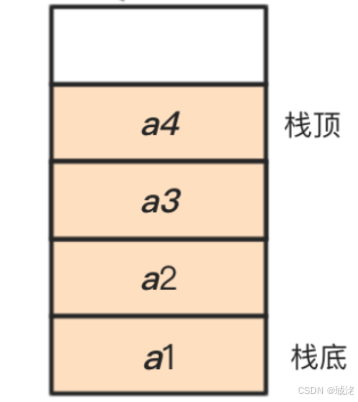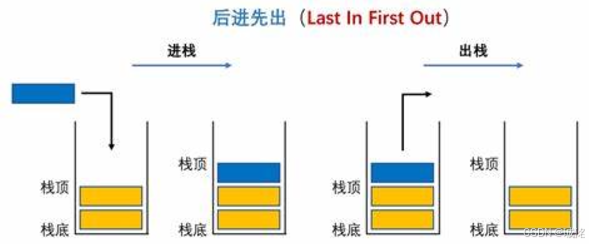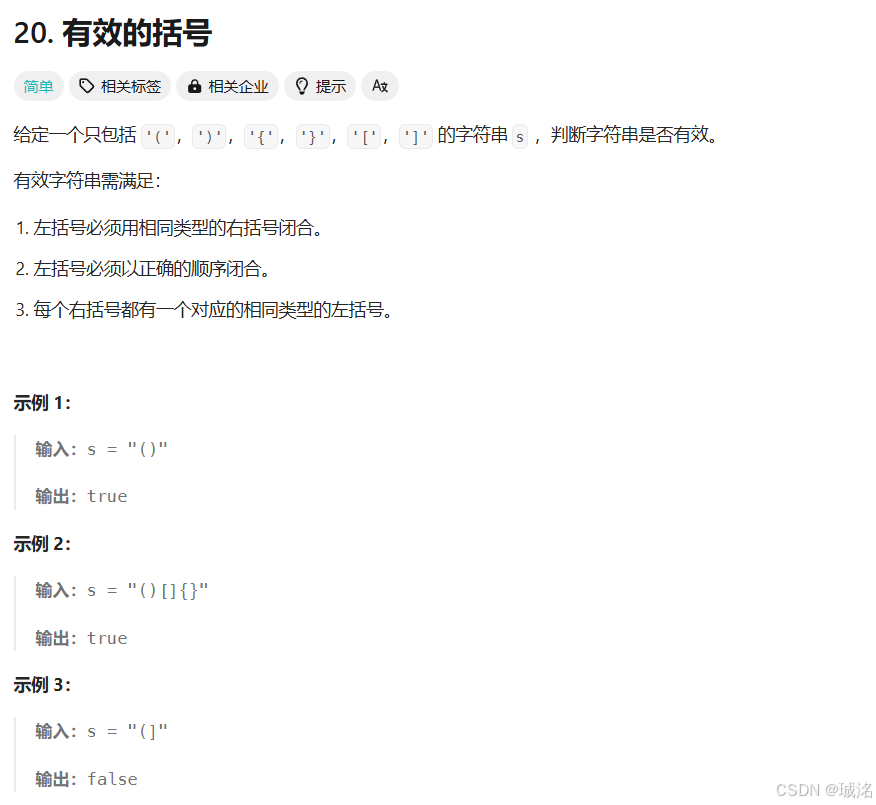C语言数据结构——详细讲解《栈》
前言
- 在 C 语言编程中,数据结构是非常重要的一部分,它能够帮助我们更高效地组织和处理数据。
- 今天,我们就来详细讲解一下其中的栈数据结构。
一、栈的概念
- “栈” 在计算机中是一种数据结构,是一种特殊的线性表,
- 它只允许在固定的一端进行插入和删除元素操作
- 进行数据插入和删除操作的一端称为栈顶,另一端称为栈底。
- 栈中的数据元素遵守后进先出的原则
- 压栈(进栈、入栈):栈的插入操作叫做进栈(压栈、入栈),入数据在栈顶
- 出栈:栈的删除操作叫做出栈,出数据也在栈顶
二、栈的定义
- 栈的结构通常由一个数组或链表来实现。
- 在数组实现中,栈顶通常由一个变量来指向,这个变量记录了栈顶元素的索引。每次入栈操作会增加这个索引,每次出栈操作会减小这个索引。
- 在链表实现中,栈顶是链表的头节点,入栈操作相当于在链表头部插入一个新节点,出栈操作相当于删除链表的头节点。
| 下面我们来详细讲一下栈的链式结构 |
- 首先,我们要定义栈的数据结构
typedef struct Stack
{
int* arr;
int top;
int capacity;
} Stack;
- arr指栈中的元素
- top指栈顶
- capacity表示栈的容量
三、栈的操作
1.初始化栈
- 有了栈的结构体定义,我们需要对栈进行初始化
void initStack(Stack* ps)
{
ps->capacity = 4;
ps->top = 0;
ps->arr = (int*)malloc(ps->capacity * sizeof(int));
assert(ps->arr!= NULL);
}
- 首先,把栈的初始容量设置为 4
- 然后,将栈顶top设置为 0,表示此时栈是空的
- 接着,使用malloc函数来动态分配内存,以便能够存储栈的元素
2. 入栈操作
栈初始化好了之后,接下来就往栈里放元素
void push(Stack* ps, int x) {
if (ps->top == ps->capacity)
{
// 栈满,扩容
int newCapacity = ps->capacity == 0? 4 : 2 * ps->capacity;
int* tmp = (int*)realloc(ps->arr, newCapacity * sizeof(int));
if (tmp == NULL) {
perror("realloc fail\n");
exit(1);
}
ps->arr = tmp;
ps->capacity = newCapacity;
}
ps->arr[ps->top++] = x;
}
这个函数就是用来把一个元素x压入栈中的
- 首先,检查一下栈是否已满了 ps->top == ps->capacity
- 如果栈满了,就得进行扩容操作
int newCapacity = ps->capacity == 0? 4 : 2 * ps->capacity;
如果当前栈的容量是 0 ,就把新容量设为 4;要是当前容量不为 0,就是当前容量的两倍
int* tmp = (int*)realloc(ps->arr, newCapacity * sizeof(int));
然后使用realloc函数来重新分配内存
- 最后,把元素x放到arr[top]这个位置上,然后再把top加 1,这样就表示栈顶元素的位置更新
3. 出栈操作
int pop(Stack* ps)
{
assert(ps->top > 0);
return ps->arr[--ps->top];
}
- 把top减 1,再返回arr[top]的值,这个值就是栈顶元素
4. 获取栈顶元素
int top(Stack* ps)
{
assert(ps->top > 0);
return ps->arr[ps->top - 1];
}
如果栈不为空,那就返回arr[top - 1]的值,这个值就是栈顶元素的值
5. 检查栈是否为空
int isEmpty(Stack* ps)
{
return ps->top == 0;
}
如果top等于 0,那就说明栈是空的,这时候函数就会返回 1;要是top不等于 0,那就说明栈里还有元素,函数就会返回 0
6.释放栈内存
void freeStack(Stack* ps)
{
free(ps->arr);
ps->arr = NULL;
ps->top = 0;
ps->capacity = 0;
}
| 以上便是栈的全部操作,下面给大家带来一道栈的例题,应用一下所学的知识 |
四、栈的例题
链接地址》》》》》》有效括号
- 大家先思考一下怎么做
题目讲解 - 思路,将左括号看为入栈,右括号看为出栈
#include <stdio.h>
#include <stdlib.h>
#include <assert.h>
// 定义栈的数据结构
typedef struct Stack {
int* arr;
int top;
int capacity;
} Stack;
// 初始化栈
void initStack(Stack* ps) {
ps->capacity = 4;
ps->top = 0;
ps->arr = (int*)malloc(ps->capacity * sizeof(int));
assert(ps->arr!= NULL);
}
// 入栈操作
void push(Stack* ps, int x) {
if (ps->top == ps->capacity) {
// 栈满,扩容
int newCapacity = ps->capacity == 0? 4 : 2 * ps->capacity;
int* tmp = (int*)realloc(ps->arr, newCapacity * sizeof(int));
if (tmp == NULL) {
perror("realloc fail\n");
exit(1);
}
ps->arr = tmp;
ps->capacity = newCapacity;
}
ps->arr[ps->top++] = x;
}
// 出栈操作
int pop(Stack* ps) {
assert(ps->top > 0);
return ps->arr[--ps->top];
}
// 获取栈顶元素
int top(Stack* ps) {
assert(ps->top > 0);
return ps->arr[ps->top - 1];
}
// 检查栈是否为空
int isEmpty(Stack* ps) {
return ps->top == 0;
}
// 释放栈内存
void freeStack(Stack* ps) {
free(ps->arr);
ps->arr = NULL;
ps->top = 0;
ps->capacity = 0;
}
bool isValid(char* s) {
Stack st;
initStack(&st);
char* pi = s;
while (*pi!= '\0') {
if (*pi == '(' || *pi == '{' || *pi == '[') {
// 入栈
push(&st, *pi);
} else {
// 判断,取栈
if (isEmpty(&st)) {
freeStack(&st);
return false;
}
char top = (char)pop(&st);
if ((top == '(' && *pi!= ')') || (top == '[' && *pi!= ']') || (top == '{' && *pi!= '}')) {
freeStack(&st);
return false;
}
}
pi++;
}
bool ret = isEmpty(&st);
freeStack(&st);
return ret;
}
| 下面详细讲解一下,对比上面代码增加的部分 |
bool isValid(char* s) {
Stack st;//定义了一个名为st的Stack类型的变量,用于辅助判断括号的有效性
initStack(&st);//调用initStack函数对栈st进行初始化
char* pi = s;
while (*pi!= '\0') {
if (*pi == '(' || *pi == '{' || *pi == '[') {
// 入栈
push(&st, *pi);
} else {
// 判断,取栈
if (isEmpty(&st)) {
freeStack(&st);
return false;
}
char top = (char)pop(&st);
if ((top == '(' && *pi!= ')') || (top == '[' && *pi!= ']') || (top == '{' && *pi!= '}')) {
freeStack(&st);
return false;
}
}
pi++;
}
bool ret = isEmpty(&st);
freeStack(&st);
return ret;
}
- 首先定义了一个字符指针pi,并将其初始化为指向传入的字符串s的首地址。这个指针将用于遍历字符串s。
- 接着循环遍历栈中的元素
- 如果等于左括号则入栈
- 然后调用push函数将该左括号字符压入栈st中
- 如果pi所指向的字符不是左括号
- 首先检查栈st是否为空。
- 如果栈不为空,调用pop函数从栈st中弹出栈顶元素,并将其转换为char类型后赋值给变量top
- 如果不匹配,则调用freeStack函数释放栈的内存
bool ret = isEmpty(&st);
当遍历完整个字符串s后,检查栈st是否为空。如果栈为空,说明所有的左括号都找到了对应的右括号,将true赋值给ret;否则,将false赋值给ret
- 最后返回ret的值
五、本文的所有代码
Stack.c
#include "Stack.h"
int main() {
Stack myStack;
initStack(&myStack);
// 入栈几个数据实例
push(&myStack, 10);
push(&myStack, 20);
push(&myStack, 30);
// 获取栈顶元素并打印
printf("当前栈顶元素: %d\n", top(&myStack));
// 出栈操作并打印出栈元素
printf("出栈元素: %d\n", pop(&myStack));
// 再次获取栈顶元素并打印
printf("当前栈顶元素: %d\n", top(&myStack));
// 检查栈是否为空并打印结果
if (isEmpty(&myStack)) {
printf("栈为空\n");
}
else {
printf("栈不为空\n");
}
// 释放栈内存
freeStack(&myStack);
return 0;
}
Stack,h
#pragma once
#include <stdio.h>
#include <stdlib.h>
#include <assert.h>
// 定义栈的数据结构
typedef struct Stack {
int* arr;
int top;
int capacity;
} Stack;
// 初始化栈
void initStack(Stack* ps) {
ps->capacity = 4;
ps->top = 0;
ps->arr = (int*)malloc(ps->capacity * sizeof(int));
assert(ps->arr != NULL);
}
// 入栈操作
void push(Stack* ps, int x) {
if (ps->top == ps->capacity) {
// 栈满,扩容
int newCapacity = ps->capacity == 0 ? 4 : 2 * ps->capacity;
int* tmp = (int*)realloc(ps->arr, newCapacity * sizeof(int));
if (tmp == NULL) {
perror("realloc fail\n");
exit(1);
}
ps->arr = tmp;
ps->capacity = newCapacity;
}
ps->arr[ps->top++] = x;
}
// 出栈操作
int pop(Stack* ps) {
assert(ps->top > 0);
return ps->arr[--ps->top];
}
// 获取栈顶元素
int top(Stack* ps) {
assert(ps->top > 0);
return ps->arr[ps->top - 1];
}
// 检查栈是否为空
int isEmpty(Stack* ps) {
return ps->top == 0;
}
// 释放栈内存
void freeStack(Stack* ps) {
free(ps->arr);
ps->arr = NULL;
ps->top = 0;
ps->capacity = 0;
}
最后一题代码
#include <stdio.h>
#include <stdlib.h>
#include <assert.h>
// 定义栈的数据结构
typedef struct Stack {
int* arr;
int top;
int capacity;
} Stack;
// 初始化栈
void initStack(Stack* ps) {
ps->capacity = 4;
ps->top = 0;
ps->arr = (int*)malloc(ps->capacity * sizeof(int));
assert(ps->arr!= NULL);
}
// 入栈操作
void push(Stack* ps, int x) {
if (ps->top == ps->capacity) {
// 栈满,扩容
int newCapacity = ps->capacity == 0? 4 : 2 * ps->capacity;
int* tmp = (int*)realloc(ps->arr, newCapacity * sizeof(int));
if (tmp == NULL) {
perror("realloc fail\n");
exit(1);
}
ps->arr = tmp;
ps->capacity = newCapacity;
}
ps->arr[ps->top++] = x;
}
// 出栈操作
int pop(Stack* ps) {
assert(ps->top > 0);
return ps->arr[--ps->top];
}
// 获取栈顶元素
int top(Stack* ps) {
assert(ps->top > 0);
return ps->arr[ps->top - 1];
}
// 检查栈是否为空
int isEmpty(Stack* ps) {
return ps->top == 0;
}
// 释放栈内存
void freeStack(Stack* ps) {
free(ps->arr);
ps->arr = NULL;
ps->top = 0;
ps->capacity = 0;
}
bool isValid(char* s) {
Stack st;
initStack(&st);
char* pi = s;
while (*pi!= '\0') {
if (*pi == '(' || *pi == '{' || *pi == '[') {
// 入栈
push(&st, *pi);
} else {
// 判断,取栈
if (isEmpty(&st)) {
freeStack(&st);
return false;
}
char top = (char)pop(&st);
if ((top == '(' && *pi!= ')') || (top == '[' && *pi!= ']') || (top == '{' && *pi!= '}')) {
freeStack(&st);
return false;
}
}
pi++;
}
bool ret = isEmpty(&st);
freeStack(&st);
return ret;
}
| 非常感谢您的阅读,喜欢的话记得三连哦 |





